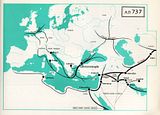
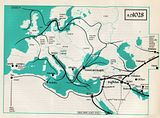
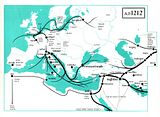
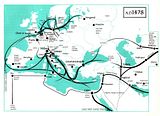
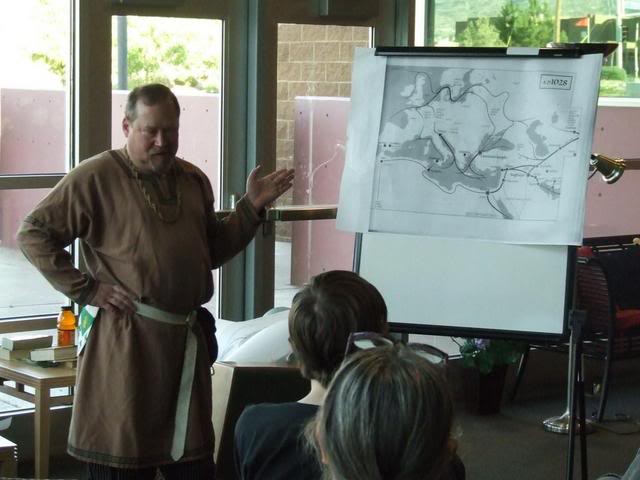 Sir Avram the Jew
Sir Avram the JewOn June 7, 2007, Sir Avram the Jew brought maps and told stories about the comings and goings of goods and people. He had enlargements of the commerce maps from The Penguin Atlas of Medieval History, by Colin McEverdy (some of which are shown below.
Avram told us that very early in a culture's development, a surplus of food leads to people being able to do other things, like make pottery, and surplus allows for trade.
A money economy (such as Rome's), and having to pay soldiers, caused things to break down from a simple barter system to the development of feudalism—working for someone in exchange for protection.
By 528 A.D. grain was being moved around by boat. Rome became a smaller city when there was no longer a Roman fleet to protect shipping. For centuries the Mediterranean was dangerously pirate-infested, and much trade went back overland or along rivers. The Silk Route and the Spice Route were stable but Mediterranean civilization was collapsing. The Black Sea was still good for getting furs, slaves, amber, and later on timber from place to place in that region.
By AD 737, Islam's impact changed economic patterns. The Arab world expanded and there was a shift in trade. Arabs were good sailors but didn't continue the old trade routes Their routes were inland along North Africa.




Frisian wool trade to what would someday be Flanders...
Because of many factors, commerce needed water, so it mostly went by river, over lakes, sea or ocean. Small and valuable things such as spices and silks could be carried by camel.
Avram said Slavs were the human material traded. Beatrice liked learning that "slave" came from the word "Slav," and AElflaed asked if "slob" and "slovenly" did too, but Avram didn't know. etymonline.com says no, they're from a Norse word having to do with wetness, slobber or something and "slob" to refer to a person is 19th century
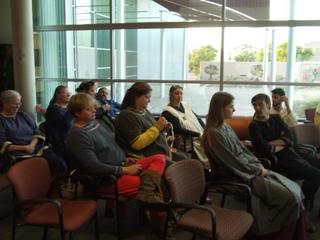
In 1028, galleys were common—long narrow ships propelled by oars. The problem is that the oarsmen limit the available space, and oarsmen need to be fed. Galleys had a mast and a sail, but went along the coast and each evening beached the ship to rest.
The lateen sail was adopted from the Middle East, after which the sails provided more of the propulsion, and oarsmen were needed only for ports and docking.
North Sea ships were larger and depended on sails. This was the heyday of the Vikings. They had broad ships that could get people to Iceland, Greenland and North America, but people had to be able to survive in the open and on cold rations. Vikings/Rus used water trade routes to get to Constantinople. They tended to try taking freely before they would barter. Trade routes were cut off by the Cuman and after that Scandinavian trade focused more on the Baltic.
Trade involved tin from England
fish from the Baltic and North Sea
gold, ivory and slaves traded by Muslems into Spain
wool, wine, corn (grains)
copper, lead and silver
furs, tallow, wax and furs (from the north).
In the 11th century the church needed candles. Oil lamps had declined in popularity and candlemaking materials were important.
Islam's pilgrim routes to Mecca were the impetus for the beginning of Christian pilgrimages to Jerusalem.
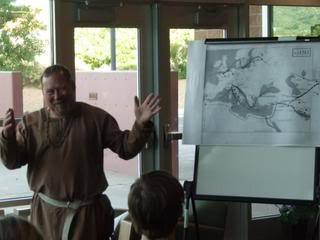 On the 1212 map, new towns were listed. Towns are marked if they had 50,000 people or more. Novgorod shows up; London was the only big city in England. Flanders needed wool, and started getting it from England and Ireland. Before the English started processing their own wool, they sent it to Flanders to be woven and fulled.
On the 1212 map, new towns were listed. Towns are marked if they had 50,000 people or more. Novgorod shows up; London was the only big city in England. Flanders needed wool, and started getting it from England and Ireland. Before the English started processing their own wool, they sent it to Flanders to be woven and fulled.
There was much less slave trade by the 13th century, because the Slavs had become Christian and so slave trade fell away.
Gold coinage arose.
Book production needed parchment, and soon paper.
Compasses and astrolabes made commerce easier and banking came in, primarily in Italy, Venice and Pisa. By the 14th C, letters of credit, like a traveller's check, encouraged trade and pilgrimage. They were easier to hide, not as bulky as coins, and a letter of credit might be used for transport of goods or people back to Venice, too.
In the 15th Century, industry was emerging. In Milan, factories produced armor and weapons and shipped them out. London, Bruge and Ghent show as trade centers by 1478. The Hanseatic League was getting fish and salt to Novgorod.
15th C, bowl-shaped ships, broad-beamed, to get to England by the Atlantic and through the English Channel, to the north Sea, two and three masted ships, cog ships that could take the weather AND the goods, with shelter for the crew and enough room for food and water (or cannon) so they could be out for months changed everything.
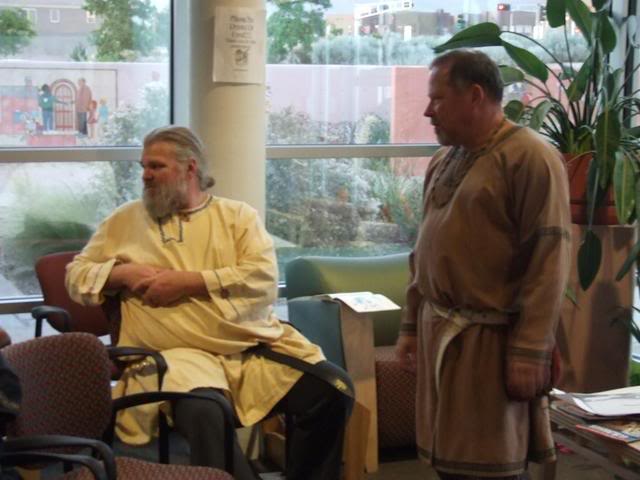
Smaller versions of those cargo ships were the kind that Columbus used to cross the Atlantic. At first the Spaniards were taking gold ore home, but later they started processing it in the Americas and taking the refined gold home. (or the English would nab it and take it to their home...) The slave/sugar/rum trade triangle evolved.
Overland trade routes required animal muscle, so along rivers for water and food was the only real way, in Europe, whether using animals or not.
The fall of Constantinople resulted in refugees taking their books to Italy, and so more and different groups of people had access to Greek philosophy and science. Printing technology was being developed. There were stable city states. People were traveling to study in universities.
Very cool fact: An ox can carry 17 days' worth of its own food. If you want the ox to carry anything besides its own food, you need to not be going very far at all. Cool MYSTERY Avram brought up: Russian and German river names begin with "D" a lot... Danube, Dnieper, Desna...
Other cool trivia: Roman emperors sometimes had German guards. In Constantinople, they would employ Varangian guards (who were Norsemen) in large part because they did NOT speak the language, and so they could speak in front of them.
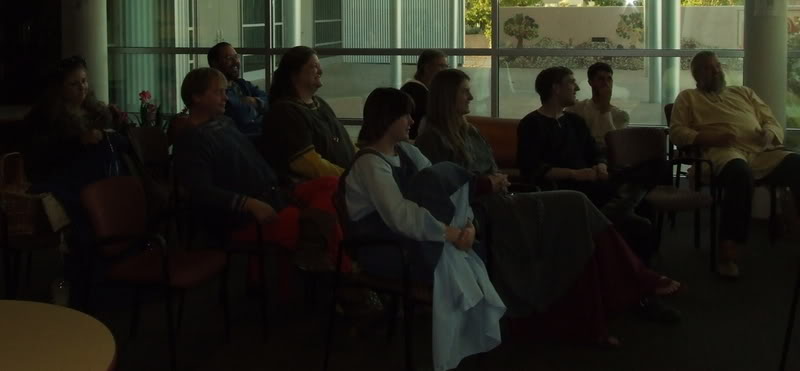
There's Asta, in the center, having fun, but after about the 13th century, she fell asleep.
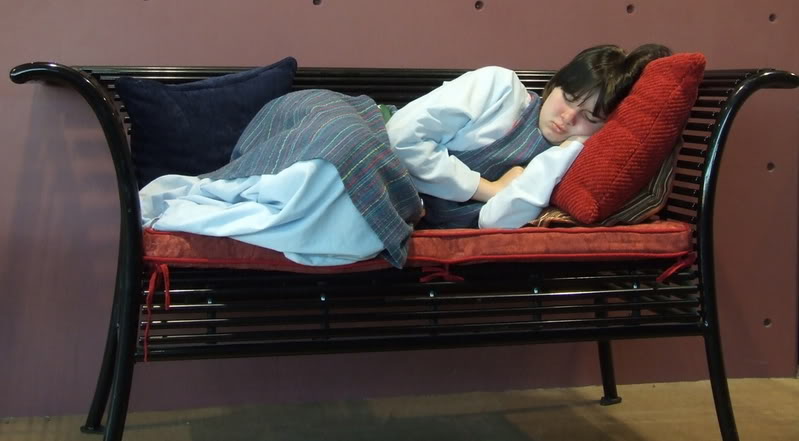 |
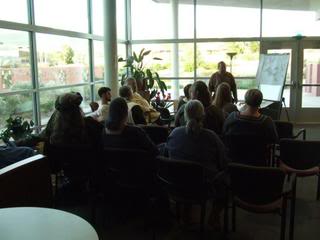
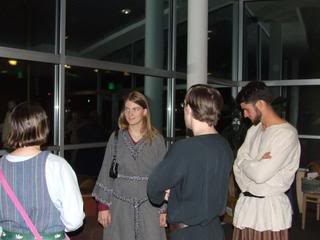
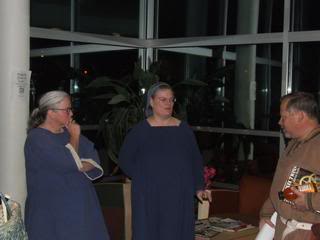
The series is available on DVD, and you can also easily watch it on YouTube with this directory listing which includes the original series and Burke's subsequent series as well.
Present:
Beatrice of Shadowskeep, Kendrick McPherson, Will Heron, Bardolf, Asta, Gunwaldt, Artan, Samuel, Triaria, Cocht Munchainn, Jehanne, Jacquette du Champ, and AElflaed